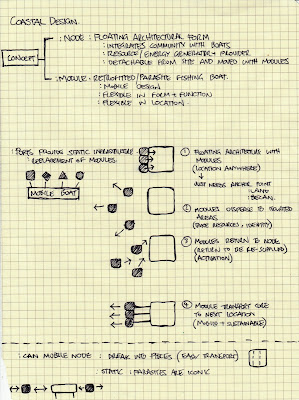Here is my initial thinking about the concept of a flexible modular unit. The modular unit can be viewed as a 'kit of parts' where a framework exists with modular units which fit within. There will be a variety of modular units which when combined/ merged form an activated node. Having a variety of modular units allow for different kits to be sent to different locations depending on the communities needs and/or situation that requires.
Saturday, 24 September 2011
|9| Modular Unit Exemplar | Micro Compact Home |
Here is an example of a modular unit which exemplifies a series of qualities I hope to achieve through my mobile design for isolated coastal regions. Check out their website http://www.microcompacthome.com/index.php.
Friday, 23 September 2011
|9| Mobile Concept Design Adjustment |
After this weeks tutorial class I have decided that maybe a mobile boat unit isn't the best response. This adjustment doesn't make my design ideas developed over the previous weeks wasted but rather just a progression of my ideas and development to reach a resolved response. I have adjusted my ideas to focus on modular units that are flexible and can be transported by boat and/or other mediums. At this stage the modular units will merge together to form a node.
|8| Conceptual Development: Design B |
I continued my focus on the idea of a mobile boat theme which could reach isolated coastal communities through the ocean sea medium. The diagrams begin to show my thought and development process as to how I see this concept evolving over the coming weeks into a mobile architecture response.
Wednesday, 21 September 2011
|8| Conceptual Development: Design |
Over the course of this week I have developed further my ideas established in week 7 and constructed a strong framework for my design to form. My focus is on Coastal Isolated regions of Australia. My mobile architecture proposes to interact with these areas providing various levels of support and resources (health, education, resources, transport, community). The primary goal of my design however will be to create opportunities to integrate and teach these people about parliament, how it works and also allowing them to provide opinions on the future development of their region and Australia as a whole. My primary goal will be to provide a network where all isolated coastal areas can interact and communicate their collective views and beliefs to the urban parliamentary system.
Friday, 9 September 2011
|7| Coastal Conceptual Development
As I begin to think and progress my individual section of the project a range of ideas have been researched. In terms of coastal communities a strong factor which I believe will play a vital role in the design relates to the harsh terrain and the most efficient and effective way to reach coastal communities within this environment. This week I have really tried to focus on what my design will achieve, how it will achieve it and the spaces/ infrastructure required to do so. Basically I am trying to develop a strong brief to structure my design off rather than going straight into a conceptual design with no foundation or idea.
Thursday, 1 September 2011
|6| Parasite Concept Thinking: Individual |
I have started thinking about my focus on parasitic architecture further and how this could relate to our strategy and coastal typology.....
|6| Parasite Reading: Biological Analogies |
I found an interesting reading on Parasitic Architecture by Merel Pit, Karel Steller and Gerjan Streng. See link below and my personal note and ideas taken. I have continued reading the second chapter of this reading "Biological Analogies" and taken notes, drawn diagrams below.
|6| Parasite identity |
| par·a·site n. 1. Biology An organism that grows, feeds, and is sheltered on or in a different organism while contributing nothing to the survival of its host. |
Core Quotes |
“A nomadic people is free-ranging, unsettled, and therefore open to adaptation as conditions change. Unchained from fixed horizons and habits of thought, physical and intellectual structures are dismantled in favour of exploration and experimentation..”
Beck, J., in Oswalt, P., 2006 (p121)
“The identity of the parasite cannot be determined completely. It is mobile and localised at the same moment. When being mobile, it can acquire its full meaning only through its installation. Its receptacle changes because of this temporal addition. At the same time, the design of the ephemeral-mobile, must take into consideration all the possibilities of settlement in places previously unknown to it.”
Papalexopoulos, D., 2002 [online] Parasites, their receptacles
and digital interconnections
and digital interconnections
|6| Coastal Exemplars |
As I progress my development of the coastal region I have found a series of exemplars who create a strong focus of identity through the landscape. I have selected three distinct Architects; Glenn Murcutt, Sean Godsell and Tom Kundig. Both Glenn and Sean are Australian designers who design in integration with the landscape whilst Tom an international exemplar follows the same ideals.
SEAN GODSELL
GLENN MURCUTT
TOM KUNDIG
Subscribe to:
Comments (Atom)























































